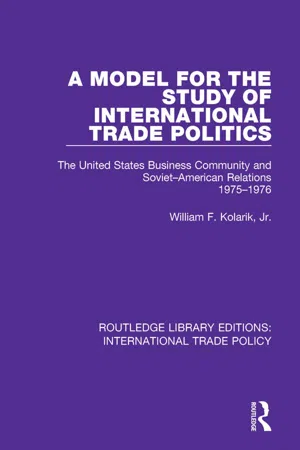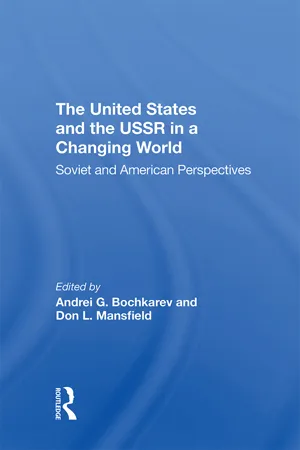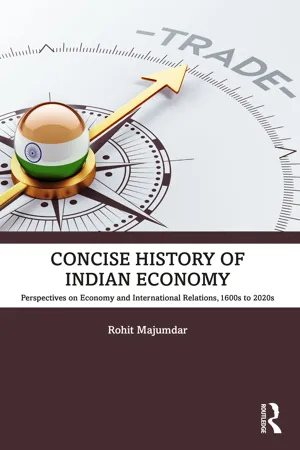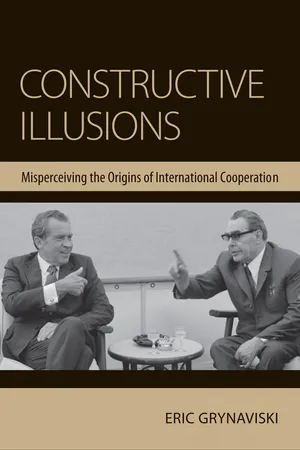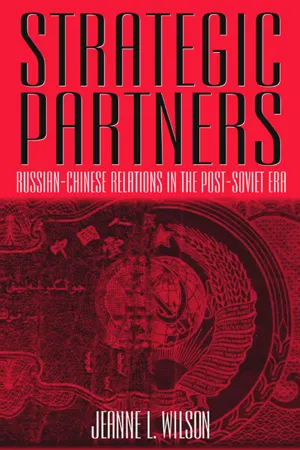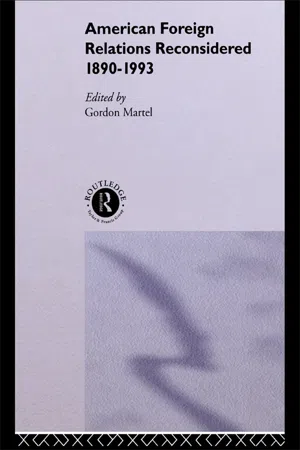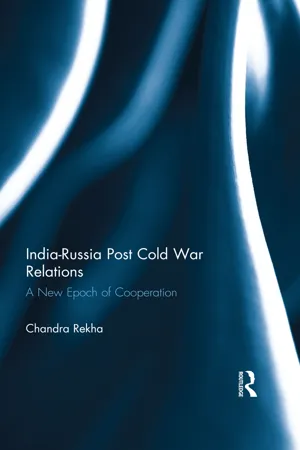History
US Soviet Relations
US-Soviet relations refer to the diplomatic, economic, and military interactions between the United States and the Soviet Union during the 20th century, particularly the Cold War era. The relationship was characterized by ideological rivalry, military build-up, and proxy wars, but also included periods of détente and cooperation. The collapse of the Soviet Union in 1991 marked a significant shift in global power dynamics.
Written by Perlego with AI-assistance
Related key terms
9 Key excerpts on "US Soviet Relations"
- eBook - ePub
A Model for the Study of International Trade Politics
The United States Business Community and Soviet-American Relations 1975-1976
- William F. Kolarik, Jr.(Authors)
- 2017(Publication Date)
- Routledge(Publisher)
CHAPTER ICOMMERCIAL ISSUES IN SUPERPOWER RELATIONS
Political Dimensions of Soviet-American Trade 1972–1981
Together with efforts to control the arms race, commercial issues have been a central feature of relations between the United States and the Soviet Union since the early 1970s. Indeed, during the uneasy U.S .-U.S.S.R. “detente” which spanned the 1972–1979 period, outstanding bilateral trade questions more often than not were the prime focus of attention of both Washington and Moscow. Clear and formal recognition of the key importance of trade and economic issues to overall political relations was initially provided by both superpowers in the “Principles of Relations Between the USA and the USSR” signed at the Nixon-Brezhnev summit meeting in Moscow in May of 1972. 1 Subsequently, the importance of trade issues was further underlined in a series of commercial agreements between the two governments concluded from 1972 to 1974.2It has been widely recognized that, from a Soviet perspective, a prime motive for embarking on a policy of detente and for concluding numerous commercial, scientific and technical agreements with Western countries has been the desire to obtain for the Soviet economy a massive and long-term infusion of Western technological knowhow and capital equipment in the hope of reviving the badly stagnating Soviet economy. Alternatively, an immediate objective of U.S. foreign policy in 1971–1972 was to capitalize on the Soviet preference for certain kinds of U.S. products and technology by quietly linking prospects for Soviet-American trade to progress on major international issues such as Berlin, the Vietnam war and arms control.3 - eBook - ePub
The United States And The Ussr In A Changing World
Soviet And American Perspectives
- Andrei Bochkarev, Don L Mansfield(Authors)
- 2019(Publication Date)
- Routledge(Publisher)
... Following the end of World War II, in which the USSR and the United States were allies, the Cold War, marking an extended period of Soviet-American confrontation, began almost immediately. Once the defeat of fascist Germany and militaristic Japan had been completed, the narrowness of the mutual basis for political cooperation became apparent. The Soviet Union's development into a real power and serious rival in the international arena resulted in a decisive parting of the ways, something that had been delayed solely by the inertia of the countries' having had a common strategic goal in World War II. Other objective causes of the sharp deterioration in Soviet-American relations include the time it took to recognize the consequences and realities of the nuclear age and the mutual inertia of established military and political concepts and doctrines (the thesis of the inevitability of a military confrontation between capitalism and socialism; the idea that it was possible to wage a nuclear war and obtain unilateral military advantages; the notion that a new world war, by analogy to the results of Worlds Wars I and II, would inevitably have revolutionary consequences). Undoubtedly, subjective circumstances, such as the views of specific leaders, a distorted interpretation of the other side's actions, also played a negative role....In contrast to the United States, the Soviet Union was prepared, of course, to continue cooperation in the postwar period. But the concept of such cooperation that we put forward had been rejected previously, in the 1930s, and it did not move Washington to abandon its policy of hard-line confrontation.... The Cold War was probably unavoidable. At the same time, it could have taken on somewhat more moderate forms if the sides had not teen guided exclusively by the tug-of-war concept that constantly led to an impasse. - eBook - ePub
The Politics of Trade Pressure
American-Soviet Relations, 1980-88
- Mohammed Ishaq(Author)
- 2019(Publication Date)
- Routledge(Publisher)
Member States had in fact become rather casual in their enforcement of controls. At the same time East - West trade had increased in comparison to previous years. The second half of the 1970s witnessed problems in Western policies towards economic relations with the Soviet bloc. Disagreements once again began emerging within the Western alliance. The U.S. had began to end its liberal approach of the early 1970s to trade with the Soviet Union in response to concerns over Moscow’s behaviour. The new more stricter US approach was not to the liking of the West Europeans who by now had considerable economic interests at stake in their trade links with the Soviet bloc. The divisions primarily between the US and its European allies intensified going into the 1980s. On top of this, as we shall see, the renewed period of conflict in East - West relations in the early 1980s proved a disaster for Soviet American economic relations in particular, and saw economic warfare one of the initial features of the cold war dictate Soviet - American issues. It might be appropriate to briefly look at the reason for the development of Soviet - American relations in the manner in which they did in particular the reasoning behind the Cold War, which actually contributed in attracting the use of U.S. trade pressure in the post - 1945 period. Since 1945 the Soviet-American relationship has oscillated rather like a business or trade cycle. The period immediately following the Second World War saw the onset of what became known as the ‘Cold War’. 7 This term was used to describe the extreme state of tension and hostility that developed between the Western powers led by the United States, and the Communist bloc of Eastern Europe led in turn by the Soviet Union - eBook - ePub
Concise History of Indian Economy
Perspectives on Economy and International Relations,1600s to 2020s
- Rohit Majumdar(Author)
- 2023(Publication Date)
- Routledge India(Publisher)
Part IX US-Soviet Relations and its Global Impact – 1956–1991: Historical and Cultural PerspectivesPassage contains an image
14 Khrushchev Thaw, Escalating Tensions, Blunders, and Soviet Collapse
Christopher Roper SchellDOI: 10.4324/9781032630618-23Reader’s Brief
The death of Stalin brought new leadership to the USSR and greater engagement with the world, but those developments also led to tension and a period of superpower conflict. How that would play out, and what forms that would take, were both varied and, at times, unexpected. The Cold war was marked by an international competition between the US and the Soviet Union but also by programs of greater cultural exchange. Oscillations between comity and antipathy would also characterize these years.Spies, crises, and potential nuclear war hung over American films at the time, while the Soviets paraded propaganda back home. Along the way, self-inflicted geopolitical and domestic wounds had profound implications in this simmering match, and overreactions and standoffs led to misunderstandings and mistakes. In the end, the Soviet system would end with a whimper and not a bang.14.1 New Direction
Just three years after Stalin’s death, and as the former Soviet leader’s body lay next to that of Lenin, Khrushchev inveighed against the “cult of personality” that he claimed had defined Stalin’s rule. In his “Secret Speech”1 at the 20th Congress of the Communist Party, Khrushchev spared no criticism. Forcefully denouncing Stalin’s “grave abuse of power” which had caused “untold harm” to the party, Khrushchev began a campaign of loosening Soviet restrictions. While shocking to many, this vigorous reassessment of Stalin’s legacy set the conditions for a new direction and leadership under the purported banner of restoring Lenin’s vision of Soviet governance.Although welcomed in the West, de-Stalinization did not sit well with all. In Khrushchev’s vocal denouncement of Stalin’s approach, China heard both a willingness to coexist with the West and a betrayal of the tenets of orthodox Marxism. Both of these were unacceptable to Chairman Mao Zedong, who had borrowed much in style and substance from Stalin. Increasingly distrustful also of India’s relationship with the USSR, China began to distance itself from the Soviet Union. This distancing accelerated in the wake of the Soviet stance of neutrality in the 1959 Sino-Indian border dispute and the 1962 Sino-Indian War. Reciprocally, the Soviet Union came to mistrust China’s hardline bellicosity and cavalier attitude towards nuclear confrontation. - eBook - ePub
Constructive Illusions
Misperceiving the Origins of International Cooperation
- Eric Grynaviski(Author)
- 2014(Publication Date)
- Cornell University Press(Publisher)
razryadka , means a relaxation of tensions. Despite its use to describe the policy of all three governments, the term meant different things to each. This section shows that the overarching relationship between the United States and the Soviet Union was a FIB. The leadership of both the United States and the Soviet Union believed that their image of détente—their understanding of the meaning of the relationship—was shared. Both superpowers were wrong. This belief was premised on a misperception; neither party accurately understood the other’s principles of détente (the values each side sought to realize from the relationship) nor their expectations for behavior (the policies the other would likely pursue). Imagined intersubjectivity, not mutual understanding, led to cooperation.In this section, I show that the meaning of détente—how the rivalry was supposed to be conducted—was different for each superpower. The emergence of strategic parity was the event that triggered each side to rethink its pre-existing beliefs. The brute fact of strategic parity was common knowledge; what it meant for the relationship was not. The Nixon administration, in particular the president’s influential aide Henry Kissinger, continued to seek political dominance. Strategic parity had reshaped the means away from arms and toward diplomacy, but political dominance remained the end. The Soviets, in contrast, believed that by reshaping the means, strategic parity had changed the ends. Military parity meant the United States had been compelled to accept the Soviet Union as an equal meriting equal prestige and that it would no longer rely on linkages or threats or prevent the Soviets from enjoying influence in the Third World. Table 2.1 - eBook - ePub
Strategic Partners
Russian-Chinese Relations in the Post-Soviet Era
- Jeanne Wilson(Author)
- 2015(Publication Date)
- Routledge(Publisher)
7 Political Relations Defining the Strategic PartnershipThere can be no doubt that geopolitical calculations loomed large in the evolution of Russian-Chinese relations during their initial decade. The specific circumstances of Russia and China diverged—in short, Russia was a descendant and China an ascendant power—but both states sought to play a significant role in the international arena. With the unfolding of the post-Cold War world order, moreover, both states came to perceive the hegemonic position enjoyed by the United States as an obstacle to the realization of this goal. By the mid-1990s, the Russian-Chinese relationship, in its international dimension, was rooted in a joint effort to influence, and most often to constrain, the actions of the United States. In this respect, the concept of the strategic triangle, long a staple of Cold War interactions between the United States, the Soviet Union, and China, still proved to be of relevance, albeit in an updated format. The much vaunted “correspondence of interests” between Russia and China on the international front, in fact, indicated their mutual preoccupation, not with each other, but with the United States as a priority of foreign policy deliberations.The international component of Russian-Chinese relations has evolved over time, the product of a diverse array of domestic and exogenous factors. Four approximate phases can be distinguished. At its outset, Russian foreign policy was determinedly pro-Western, pursuing a policy of outright rejection of its communist past. This endeavor could evoke only distaste on the part of the Chinese leadership, still reeling from the domestic impact of the Tiananmen events and the virtual collapse—China itself being the most prominent exception—of the international communist system. Under such circumstances, it was a struggle for Russia and China to identify convergent international interests. The Russian romance with the West proved to be short-lived and its attenuation served as a catalyst for the rejuvenation of the international dimension of Russian-Chinese relations. In this second phase, Russia and China edged closer in their appraisals of the nature of the international political order, a process that was formalized in their 1994 joint communiqué that defined their relationship as a “constructive partnership.” The section of the joint communiqué dealing with international issues indicated the intention of the two states to intensify their cooperation, noting their mutual regard for each other as “major powers” with an important role to play in a world heading toward multipolarity.1 - eBook - ePub
- Gordon Martel(Author)
- 2002(Publication Date)
- Routledge(Publisher)
The revisionists had a great impact on assessments of US foreign policy because they accurately demonstrated that American officials were not naive, simple-minded, and defensive. Marshalling considerable evidence, they showed that Roosevelt, Truman, and their advisers grasped the likelihood of a postwar struggle with the Soviet Union and sought to safeguard US interests. These interests were shaped by the tradition of expansion in American history, by the dynamics of the American political economy of liberal capitalism, by a sense of political and racial superiority, by a need to avoid the mistakes of political isolationism and economic nationalism that had plagued the interwar years, and by the futile experience of trying to appease totalitarian foes. These revisionist views were anathema to traditionalists and conservatives because they suggested that the United States shared responsibility for bringing on the Cold War.Revisionist interpretations were gaining ascendancy in the early 1970s when John Lewis Gaddis published his prize-winning book The United States and the Origins of the Cold War. Gaddis did not deny that Stalin’s objectives were limited and he did not dispute that economic and ideological variables played a role in the formulation of American foreign policy. Hence he sought to coopt elements of the revisionist critique. But, while acknowledging that these factors were worthy of historical attention and while agreeing that US actions raised Soviet suspicions, he contested the centrality of their importance. Instead, he stressed the profound significance of the domestic political system, of partisan politics, of ethnic voting blocs, and of legislative-executive rivalries. “The delay in opening the second front [in Europe during World War II], nonrecognition of Moscow’s sphere of influence in Eastern Europe, the denial of economic aid to Russia, and the decision to retain control of the atomic bomb can all be explained far more plausibly by citing the Administration’s need to maintain popular support for its policies rather than by dwelling upon requirements of the economic order.”21 - eBook - ePub
- Michael Don Ward(Author)
- 2022(Publication Date)
- Routledge(Publisher)
As allies in that war, the United States and the Soviet Union were intensively involved in Eurasia. In the late 1940s the intensity of involvement of both the United States and the Soviet Union became less (Figure 1). This reduction of military involvement was, however, of short duration. At the end of the 1940s the rivalry between the United States and the Soviet Union became manifest. Europe was at this time of course the central theater. Soviet refusals to give up control of Eastern Europe, and American assertions in Western Europe and Greece and Turkey, played a key role in the rapid deterioration of US-Soviet relations. The end of the decade was a breaking point in that military involvement of both powers started to rise again (Figure 2). The early 1950s saw a sharp increase of US involvement in both overall intensity and in the number of countries. The increase of Soviet involvement at this time was far less impressive. Figures 7 and 8 indicate the striking preponderance of the United States in the period 1948-1952. Soviet involvements are confined to East and West Europe and Iran. The involvements of the Soviet Union in the United Kingdom, Germany and France reflect the earlier mentioned legacy of the Second World War (e.g., the status of Berlin). American activity, apart from Latin America, stretches out along the Eurasian littoral and is concentrated in West Europe, East Asia, and Iran. Largely due to the Korean war, American involvement in the Inner Ring was most salient: it was twice as intensive as American involvement in the Rimland (which contains nearly four times as many countries as the Inner Ring) and more than ten times as intensive as Soviet involvement in the Inner Ring (Table I) - eBook - ePub
India-Russia Post Cold War Relations
A New Epoch of Cooperation
- Chandra Rekha(Author)
- 2017(Publication Date)
- Routledge(Publisher)
Consequently, this chapter reviews the evolution of the bilateral relations between India and Russia in the post Cold War era alongside a brief historical survey of the factors and conditions that prompted the two allies to develop a strong partnership during the Cold War period. The chapter has been divided into two sections. The first section aims to understand the foreign policies of Soviet Russia and India during the Cold War era, and the factors and circumstances that motivated their international behaviour. This segment also provides an insight into the decisions of the leaders and policy-makers of both countries, their goals towards stronger ties, keeping in mind the international system in the bipolar world and the shifts that took place in their respective foreign policy orientations. It also seeks to provide a chronological framework of the impact of the Cold War period on the relations between India and the Soviet Union. The second section of the chapter focusses on the developments that took place in the bilateral relations between India and Russia in the post Cold War period, the predicaments that emerged in the initial phase of the Soviet disintegration, the policies and reforms that were initiated by the two entities to strengthen bilateral ties, and the external factors that influenced the changes in the foreign policy approach in the strategic partnership of the two countries.In order to draw out the essence of the strategic culture that has evolved in India’s and Russia’s foreign policy outlook, let us look into the various factors that have determined the international behaviour of both New Delhi and Moscow. The foundation of the strategic culture of both India and Russia can mainly be attributed to the events and developments of the 20th century which were mostly an outcome of internal factors such as culture, economic status, demography of the state, ideology, personality cult and the role of political elites in determining the foreign policy doctrine, while the external factors include the status quo in the international system, coalitions with other countries, foreign threats and, more importantly, change in the balance of power.Historical Background of Indo-Soviet Relations during Cold War Period
During the Cold War period, the world was divided into two superpower blocs: one dominated by the United States and the other by the Soviet Union. While this period saw the struggle for status quo and balance of power post World War II, it also marked the end of the ultra-nationalist ideologies of Fascism, Nazism, Racism, Colonialism and Imperialism. There was decolonisation of the Asian, African and Latin American countries that led to the emergence of many new states, including India, which gained independence in 1947 from the British Empire. The decolonisation movement triumphed as world politics after the end of World War II was enshrined in the United Nations’ concept of national self-determination and global development.1
Index pages curate the most relevant extracts from our library of academic textbooks. They’ve been created using an in-house natural language model (NLM), each adding context and meaning to key research topics.
